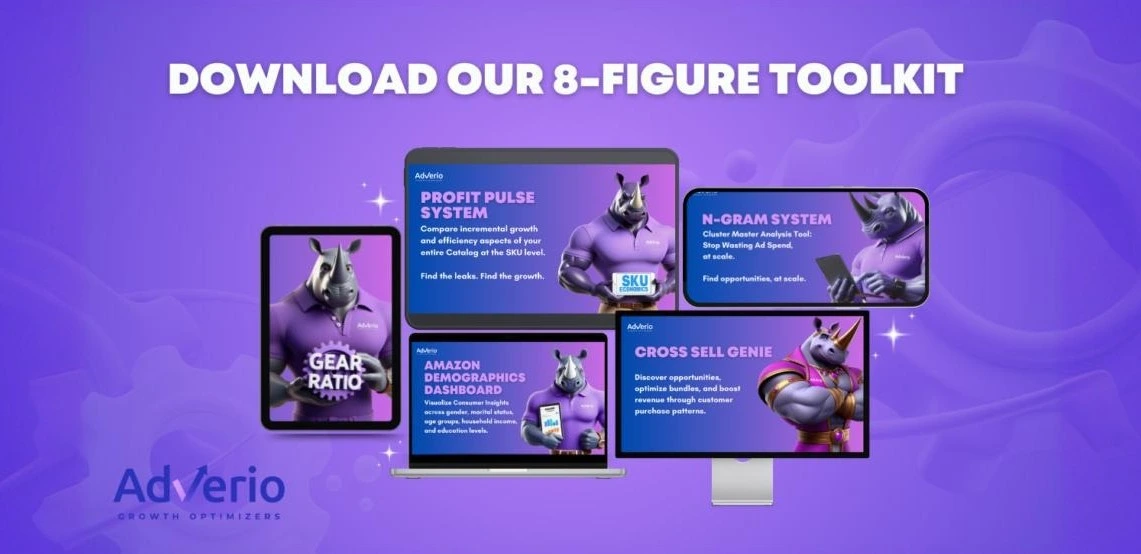Overview on Amazon’s Underperforming Campaigns
Managing Amazon PPC campaigns can be challenging as there are many moving parts that impact performance. It’s common for campaigns to experience periods of underperformance due to changes in the Amazon marketplace, shifts in customer behavior, and suboptimal campaign settings. However, with the right strategy and optimizations, you can turn around underperforming Amazon campaigns.
- Let’s explore why campaigns fail to meet their potential and how strategic bid optimization can address these challenges. We’ll learn three highly effective methods for PPC bid management, offering actionable insights that you can start implementing today to maximize your campaign’s impact.
Why Do Most PPC Campaigns Underperform?
1. One-Size-Fits-All Bid Management
Many brands rely on basic bid settings, often assuming they’ll yield steady performance. However, this “set it and forget it” approach doesn’t account for variations in keyword performance, audience behavior, or seasonal shifts.
2. Lack of Data-Driven Adjustments
PPC campaigns require ongoing refinement based on performance metrics. Without regular data analysis, keywords that once worked well may start draining ad spend, while high-performing keywords remain underutilized.
3. Manual Errors and Oversights
Even with the best intentions, manual bid adjustments are prone to errors, and important details are often overlooked. This is especially true for larger accounts, where managing hundreds or thousands of keywords can be overwhelming.
4. Missed Opportunities with High-Intent Keywords
Campaigns often fall short when brands overlook or underbid on keywords that drive high-intent traffic. Proper optimization focuses on capturing these valuable clicks, ensuring they’re prioritized and adequately funded.
Implementing a thoughtful bid optimization strategy can solve each of these common issues. Let’s explore three effective methods, each suited to different campaign goals, budgets, and account sizes.
3 Key Ways to Fix Underperforming Amazon Campaigns
Strategy 1: Weekly Bid Tuning with the Targeting Tab
If you’re managing a smaller account and need a straightforward, time-efficient approach, the targeting tab provides a simple way to control ACoS and manage bids without overwhelming amounts of data.
- Filter by Active Campaigns: Focus only on active keywords and campaigns to avoid distractions from paused elements.
- Segment Keywords by ACoS Thresholds:
-
- For keywords with ACoS far above your target, apply a larger bid decrease to bring them closer to profitability. Start with a 10-15% decrease for those with an ACoS significantly above your target.
- As keywords get closer to the target ACoS, the number of bid changes is reduced. For example, if your target ACoS is 30%, apply a 5% decrease to keywords within 10% of that target.
- Conservatively Increase Bids on Low-ACoS Keywords:
-
- Identify keywords significantly below target ACoS and increase bids by around 5-10% to capture more clicks without overshooting.
This process can be completed once a week for small accounts. While effective for maintaining a consistent ACoS, this approach does require a careful balance between bid increases and decreases to prevent over-adjustment. The targeting tab is a great start but has limitations in handling large-scale data for more complex campaigns.
Strategy 2: Revenue Per Click (RPC) Bidding—For Scaling Control and Precision
For mid-sized to large accounts, manual targeting tab adjustments may not suffice. Revenue Per Click (RPC) bidding offers a data-driven approach that ties your bid adjustments directly to the revenue each click generates.
- Download Bulk Data for Precision Filtering:
-
- Using Amazon’s Bulk Operations tool, export a 30-day data file and filter out any keywords with fewer than two orders or fewer than ten clicks. This narrows your focus to statistically significant keywords.
- Calculate Optimal Bids Based on Revenue per Click:
-
- Apply a formula that divides sales by clicks and then multiplies by your target ACoS. This provides an accurate bid based on actual keyword performance.
- Identify High-Spend, Low-Conversion Keywords:
-
- Filter for keywords with high clicks but zero orders, then reduce these bids by 20-30% to save on ad spend. This ensures that resources aren’t wasted on non-converting keywords while freeing up the budget for higher-potential bids.
RPC bidding allows for more granular control and can be done more frequently—daily if needed. However, a disciplined approach is required to ensure bid changes align with trends rather than isolate spikes in performance.
Strategy 3: Fully Automated AI-Based Bid Management – The Solution for Large-Scale, Dynamic Campaigns
AI-based automation is the most efficient and reliable approach for large accounts managing extensive ad budgets. AI goes beyond standard bid adjustments by leveraging advanced algorithms to assess each keyword’s performance in real time.
- Set Target ACoS for Automated Adjustments:
-
- Start by setting target ACoS levels for each campaign, then activate the automation tool. AI will continually analyze keyword performance and adjust bids automatically, focusing on high-ROI keywords.
- Advanced Placement Control:
-
- With AI, you can optimize bids by placement. For example, if a keyword performs well at the top of the search, the AI tool can allocate more of the budget while reducing spending on lower-performing placements.
- Hourly and Daily Performance Bidding:
-
- PPC performance can vary throughout the day and week. AI automatically adjusts bids based on hourly and daily data, conserving budget during off-peak times and increasing ad spending when traffic is high.
Unlike manual processes, AI automation offers hands-off optimization, freeing up time for strategic decisions rather than day-to-day adjustments. This approach yields more precise control, reduced wastage, and consistent results for brands with significant ad spend.
Choose the Right Strategy for Your Brand
Choosing the right bid optimization approach depends on several factors, including budget size, campaign complexity, and desired level of involvement. Targeting tab adjustments can offer adequate control if you focus on cost-effectiveness and simplicity.
RPC bidding provides scalable efficiency for those managing larger accounts or seeking greater precision. Finally, if maximizing every dollar is the priority, AI-driven automation offers unmatched accuracy and time savings.
Ready to unlock your Amazon PPC potential? Let’s discuss how our advanced bid optimization strategies can help you drive better results and higher profitability—without the guesswork. Contact us today to learn more.
Frequently Asked Questions (FAQs) – How to Fix Underperforming Amazon Campaigns
1. What are some common reasons for Amazon PPC campaigns to underperform?
Using a one-size-fits-all bid approach, lack of data-driven adjustments, manual errors, and overlooking high-intent keywords.
2. How can I optimize bids on a weekly basis for a smaller Amazon campaign?
Use the Targeting tab to filter by ACoS thresholds and adjust bids up or down based on performance.
3. What is revenue per click (RPC) bidding?
An approach that ties bid adjustments directly to the revenue generated per click. It allows for more granular control through bulk data exports and daily adjustments.
4. How does RPC bidding work?
Export bulk data, filter keywords, calculate optimal bids based on revenue per click multiplied by target ACoS, and adjust bids on underperforming keywords.
5. What are the benefits of AI-based bid optimization?
Hands-off automation, reduced wastage, consistent results, optimization by placement and time of day/week based on vast amounts of data.




























